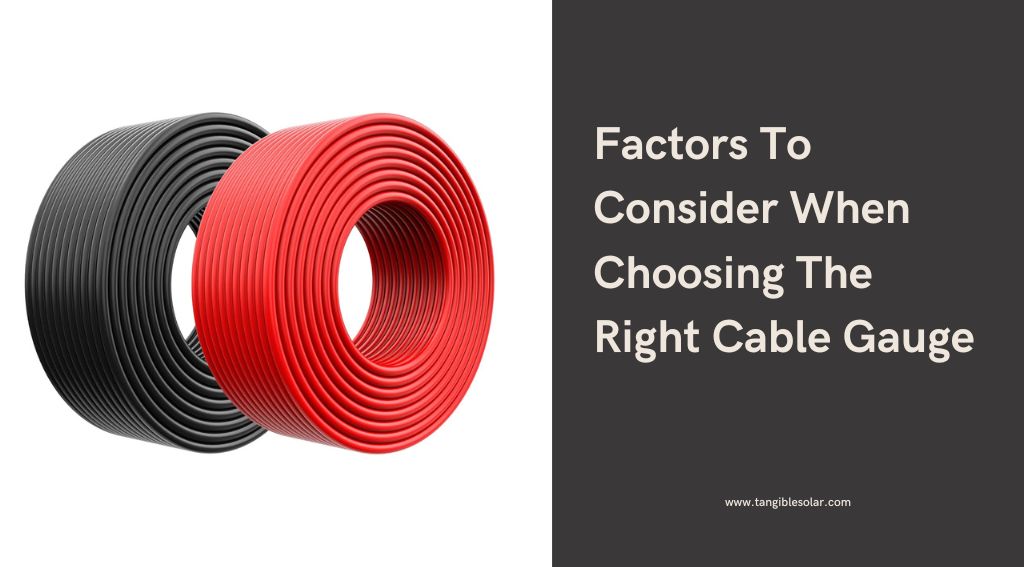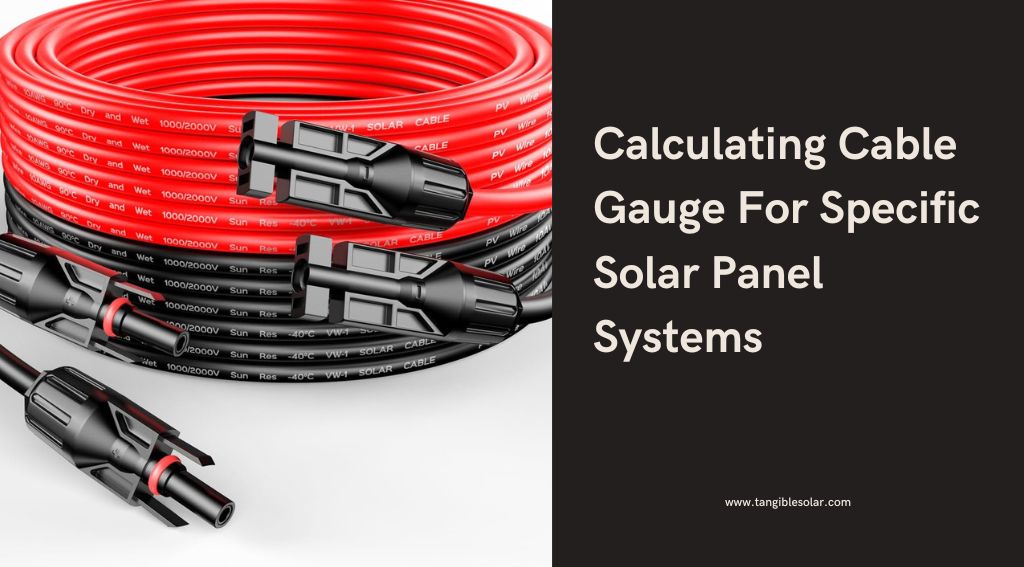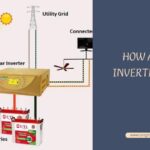What Size Cable from Solar Panel to Inverter?
The size of the cable from the solar panel to the inverter depends on the wattage and distance involved. To determine the appropriate cable size, consider the wattage of the solar panel and the distance between the solar panel and the inverter.
Solar panels produce electricity that needs to be transmitted to the inverter for conversion into usable AC power. The cable size is critical to maintaining the efficiency and performance of the system. If the cable is too small, it can cause a voltage drop and energy loss.
On the other hand, using oversized cables can be costly and unnecessary. By correctly sizing the cable, you can ensure the maximum output of your solar system. We will discuss the factors to consider and provide guidelines for selecting the right cable size from the solar panel to the inverter.
The Importance Of Cable Gauge In Solar Panel Systems
When it comes to setting up a solar panel system, choosing the right cable gauge is crucial for optimum performance and efficiency. The cable gauge, also known as wire size, plays a significant role in determining the amount of power that can be safely transferred from the solar panels to the inverter. Whether you are designing a new solar panel system or upgrading an existing one, understanding the importance of cable gauge is essential to ensuring the smooth functioning of your solar installation.
How to Reset Solar Edge Inverter
How Cable Gauge Affects Power Transfer Efficiency
The cable gauge has a direct impact on the power transfer efficiency of a solar panel system. A thicker cable gauge allows for lower resistance, minimizing losses during power transmission. On the other hand, a thinner cable gauge can lead to higher resistance, causing power losses and reducing overall system efficiency. Therefore, selecting an appropriate cable gauge based on the distance between the solar panels and the inverter is crucial to ensuring optimal power transfer.
Let’s take a closer look at the relationship between cable gauge and power transfer efficiency:
| Cable Gauge (AWG) | Maximum Recommended Distance | Power Transfer Efficiency |
| 10 | 100 feet | High |
| 8 | 200 feet | Very High |
| 6 | 400 feet | Excellent |
| 4 | 800 feet | Superior |
As the table above illustrates, using a larger cable gauge, such as 10 AWG, for shorter distances can ensure high power transfer efficiency. However, if the distance between the solar panels and the inverter is greater, a thicker cable gauge, such as 4 AWG, is recommended to maintain superior power transfer efficiency.
It’s important to note that the cable gauge is not the only factor that affects power transfer efficiency. Factors like temperature, weather conditions, and the installer or electrician are advisable to determine the most suitable cable gauge for the conditions, and system voltage also plays a role. Therefore, consult with a professional solar-specific solar panel system.
Factors To Consider When Choosing The Right Cable Gauge

Factors to Consider When Choosing the Right Cable Gauge When it comes to setting up a solar panel system, choosing the right cable gauge is essential for optimal performance and safety. The cable that connects your solar panels to the inverter plays a crucial role in transferring power efficiently and effectively. Various factors need to be considered when selecting the appropriate cable gauge, including distance, current, and voltage.
How To Connect Solar Panel To Inverter Without Battery
The Role Of Distance In Determining Cable Gauge
The farther the distance, the more resistance the cable will encounter, resulting in power loss. To minimize this power loss and ensure efficient power transfer, it is crucial to use the appropriate cable gauge. As a general rule of thumb, the longer the distance, the thicker the cable gauge should be. Thicker cables have lower resistance and can effectively transmit power over longer distances. This helps to minimize power loss and maintain the efficiency of your solar panel system.
Current And Voltage Considerations For Optimal Power Transfer
| Distance (ft) | Recommended Cable Gauge (AWG) |
| 0 – 25 | 10 |
| 26–50 | 8 |
| 51 to 100 | 6 |
| 101 – 200 | 4 |
Note: The table above is a general guideline and may vary depending on the specific requirements of your solar panel system. It is always recommended to consult with a professional to determine the appropriate cable gauge for your setup. In conclusion, selecting the right cable gauge is crucial for the efficient and safe operation of your solar panel system. Considering factors such as distance, current, and voltage will help you determine the appropriate cable gauge to minimize power loss and maximize the performance of your solar panel system.
Calculating Cable Gauge For Specific Solar Panel Systems

Calculating Cable Gauge for Specific Solar Panel Systems
One of the critical aspects of designing a solar panel system is determining the appropriate cable gauge for the connection between the solar panels and the inverter. The cable gauge refers to the thickness or size of the cable, which determines its current-carrying capacity. Choosing the right cable gauge is essential to ensuring efficiency and safety in the system.
Understanding The Calculation Methods For Cable Gauge Determination
When determining the appropriate cable gauge for your solar panel system, there are two primary calculation methods to consider. These methods take into account the power output of the solar panels, the distance between the panels and the inverter, and the operating voltage of the system.
- Current-carrying capacity method: This method involves calculating the maximum current that the cable needs to carry based on the total power output of the solar panels. The current is determined by dividing the total power output by the system voltage. Once you have the maximum current value, you can refer to industry-standard tables or online calculators to determine the appropriate cable gauge.
- Voltage drop method: This method focuses on minimizing voltage drop along the length of the cable. A voltage drop occurs due to the resistance of the cable, which increases with cable length and current flow. By keeping the voltage drop within an acceptable range (usually around 3%), you can ensure optimal performance of your solar panel system. To calculate the cable gauge using this method, you need to consider the total cable length, the desired voltage drop, and the estimated current flowing through the cable.
Examples And Case Studies On Cable Gauge Calculation For Various System Sizes
Let’s explore some examples and case studies that demonstrate the cable gauge calculation for different solar panel system sizes:
| Solar Panel System Size | Total Power Output (W) | System Voltage (V) | Maximum Current (A) | Recommended Cable Gauge |
| 5 kW | 5000 | 240 | 20.83 | 8 AWG |
| 10 kW | 10000 | 480 | 20.83 | 6 AWG |
| 20 kW | 20000 | 480 | 41.67 | 4 AWG |
In the above table, the recommended cable gauge is determined using the current-carrying capacity method. As the power output and maximum current increase, a thicker cable gauge is required to accommodate the higher current flow.
By understanding the calculation methods and considering examples or case studies, you can confidently determine the appropriate cable gauge for your specific solar panel system. This ensures optimal performance, efficiency, and safety throughout the life of your solar installation.
Consequences Of Choosing The Wrong Cable Gauge
Potential Issues Caused By Incorrect Cable Gauge Selection
Choosing the wrong cable gauge for your solar panel-to-inverter connection can have serious consequences. It is crucial to understand the potential issues that may arise as a result of improper gauge selection. From losses in power efficiency to safety hazards, ignoring the importance of using the right cable size can lead to significant setbacks in your solar system’s performance.
How to Connect Solar Panel to Inverter
Losses In Power Efficiency And Safety Hazards Associated With Improper Gauges
One of the primary concerns when using the wrong cable gauge is the loss of power efficiency. When the cable size is inadequate, it can create resistance and hinder the efficient flow of electricity. This resistance results in power losses, ultimately reducing the overall efficiency of your solar system. You might end up generating less electricity than expected, impacting your energy savings and return on investment.
Furthermore, improper gauge selection can give rise to safety hazards. Insufficiently sized cables can heat up due to the increased resistance, which can lead to the melting of cable insulation and potential short circuits. This poses both a fire hazard and a risk of electrocution. These safety concerns underline the importance of selecting the correct cable gauge to ensure the smooth and safe operation of your solar panel system.
Another consequence of using the wrong cable size is the increased likelihood of a voltage drop. A voltage drop occurs when the cable is unable to maintain the required voltage level over a distance. This drop in voltage can impact the performance of your solar system, particularly if the distance between the panel and the inverter is significant. It can result in diminished power output and affect the system’s ability to meet your energy needs.
Best Practices For Selecting The Optimal Cable Gauge
When it comes to a solar power system, selecting the right cable gauge is crucial for reliable and efficient performance. The cable connecting the solar panels to the inverter plays a significant role in properly transferring the generated power. In this article, we will explore the industry recommendations, guidelines, and factors to consider when selecting the optimal cable gauge.
Industry Recommendations And Guidelines For Cable Gauge Selection
Industry experts have put forth recommendations and guidelines to help individuals select the proper cable gauge for their solar inverter connections. These recommendations are based on maximum power efficiency, safety, and compliance with industry standards. The following table provides an overview of the commonly suggested cable gauges:
| Solar Panel Output (Watts) | Cable Gauge (AWG) |
| Up to 100 | 14 |
| Up to 200 | 12 |
| Up to 400 | 10 |
| Up to 800 | 8 |
| Up to 1200 | 6 |
Factors To Consider For Maximum Power Efficiency And Safety
When selecting the optimal cable gauge for your solar panel-to-inverter connection, several factors should be taken into consideration:
- Distance: The length of the cable between the solar panels and the inverter affects the voltage drop and power losses in the system. Longer distances require thicker cables to minimize power loss and maintain efficiency.
- Current: The amount of current flowing through the cable impacts the resistance and voltage drop. Higher current requires thicker cables to prevent excessive power loss and ensure optimal performance.
- Temperature: Cables can undergo temperature changes due to weather conditions and solar radiation. It is essential to choose cables with appropriate insulation and temperature ratings to ensure long-term durability and safety.
- Code and Standards: Adhering to local electrical codes and industry standards is crucial for safety and compliance. Consult with a qualified electrician to ensure the cable gauge selection aligns with the applicable regulations in your area.
By considering these factors and following industry recommendations, you can select the optimal cable gauge for your solar panel-to-inverter connection. This ensures maximum power efficiency, minimizes power loss, and enhances the overall safety and performance of your solar power system.
FAQs: What Size Cable from Solar Panel to Inverter
What size cable do I need from the solar panel to the inverter?
To determine the cable size needed from the solar panel to the inverter, you should consider factors such as the distance between the panel and the inverter, the current capacity of the solar panel, and the voltage drop. It’s recommended to consult an electrical engineer or refer to the manufacturer’s guidelines for the specific requirements of your solar panel system.
How Can Cable Size Impact the Performance of a Solar Panel System?
The cable size plays a crucial role in the performance of a solar panel system. If the cable is too small, it can cause a sive voltage drop and result in power loss. On the other hand, using a larger cable than necessary can be expensive and inefficient.
Properly sizing the cable ensures maximum energy transfer and optimal performance of the solar panel system.
Are There Any Specific Guidelines For Cable Sizing In Solar Panel Installations?
Yes, there are specific guidelines for cable sizing in solar panel installations. It is recommended to follow the national and local electrical codes, as well as the manufacturer’s guidelines. These guidelines provide information on factors such as maximum allowable voltage drop, current capacity, and cable distance, ensuring the safe and efficient operation of the solar panel system.
How Can I Calculate The Voltage Drop In A Solar Panel System?
To calculate the voltage drop in a solar panel system, you can use online calculators or formulas specified in the electrical codes. The calculation takes into account factors such as cable length, current capacity, cable type, and voltage level. By accurately determining the voltage drop, you can select the appropriate cable size to minimize power loss and optimize the performance of your solar panel system.
Conclusion
Choosing the right cable size from solar panel to inverter is crucial for optimal performance. By ensuring the cable size matches the current and length requirements, you can minimize power loss and maximize efficiency. Remember to consider factors such as voltage drop and temperature rating to maintain the integrity of your solar system.
Consulting a professional can provide valuable insights and ensure a smooth installation process. Don’t underestimate the importance of proper cable sizing to harness the full potential of your solar energy system.




